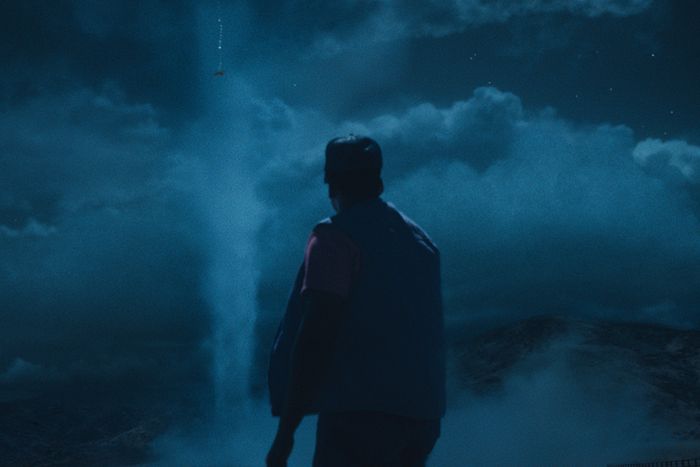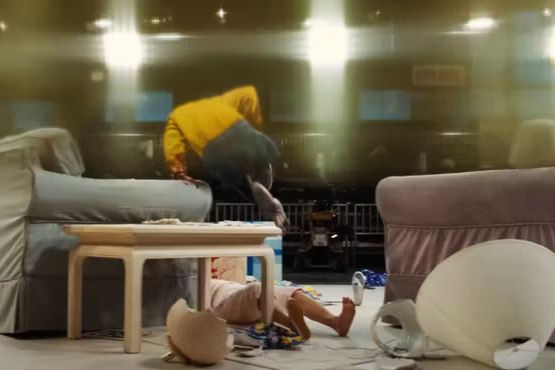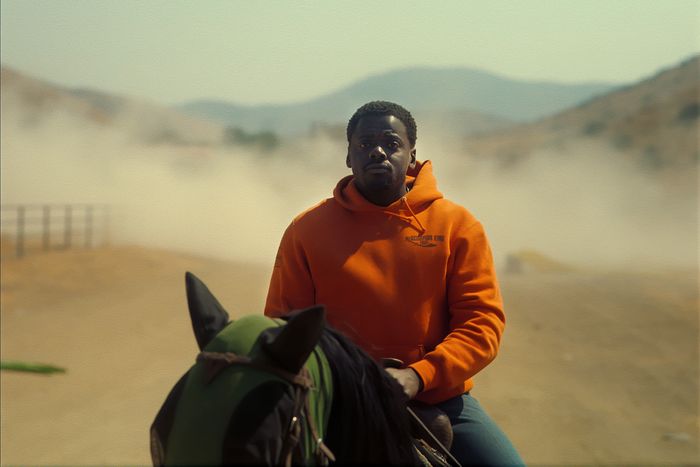
This article was featured in One Great Story, New York’s reading recommendation newsletter. Sign up here to get it nightly.
Jordan Peele’s new horror-comedy, Nope, stars Daniel Kaluuya and Keke Palmer as Otis Jr. and Emerald, the sibling proprietors of Haywood’s Hollywood Horses. As they attempt to capture video evidence of a mysterious being attacking their ranch from the clouds, Nope stretches out like a camera’s bellows to the wide-open landscapes and cyclone-filled sky in a way that recalls The Wizard of Oz. OJ and Em team up with a cinematographer named Antlers Holst (Michael Wincott) to nab footage of the alien using a hand-cranked IMAX camera the Nope crew referred to as “Dorothy.” During filming, Wincott shadowed the film’s own cinematographer, Hoyte van Hoytema, to study up on his role (and even ended up wearing one of his scarves in the film). “Photography, or how we photograph things, and the chemistry of photography, is a very big theme in the film,” says van Hoytema, who broke down a few key scenes that play with the idea of how much we’re able to see.
The Nights
Much of Nope takes place at night, when the Haywood siblings realize that their horses are being hunted and their house targeted. An early scene follows Kaluuya’s OJ as he investigates lights left on in the ranch’s barn, while another horrifying sequence mid-film involves the house being drenched in blood as a thunderstorm rages.
The shots I’m particularly proud of are the exterior nights. We wanted specific things from them. Night shoots are always hard to achieve so a lot of engineering went into coming up with technology that would enable us to do things that normally wouldn’t have been possible. In a conventional horror film, the horror is very often in what you can’t see. And at the same time, it is that idea of something threatening being present in a very big expanse. When you think about Jaws, the sea is so wide open and the danger can come from everywhere. That danger is extremely concrete. The spaciality, the expanse of it, makes it terrifying in many ways. Jordan wants to do a very similar thing but with the sky. The sky is all around us, so it’s a very big space where danger can be, live in, or can come from.
The way Nope’s terror unraveled, we would treat nights and days kind of the same. Neither is a safe haven for our main heroes. Now, for the nights, it’s very difficult, because especially when you’re out in a valley, for instance, or where there’s hardly any photographable light. So you’re very dependent on using film lighting. And film lighting, once you start lighting a scene at night, the pools of light you can create become very limited. Your space only exists within what you’re lighting up, and the rest is just darkness. It’s a void, in a way. What we wanted to do was to create nights that were very vast. Especially in the beginning, in the scenes where OJ goes out alone, looks around, and feels the presence of something. Then he sees something. And then we, as an audience, can just about make out what he would be able to just about make out. We wanted to be suggestive, but we also wanted to give the audience the same level of experience as he would have had. You can actually see through the night. And once you are standing in the darkness long enough, your pupils dilating, you can make out the mountain ridges, the clouds in the night sky, and the stars behind it. You start to see the glow of the city in the distance and all these kinds of things.
The Kid’s-Eye View
Steven Yeun plays Jupe, a former child actor who witnessed a horrific chimpanzee attack on a sitcom set. As an adult, he lives next to the Haywoods and runs a western-themed amusement park. Nope recurrently visits that gruesome disaster, aligning our perspective with that of young Jupe (Jacob Kim) as he hides under a table and focuses on a woman’s shoe that seemingly defies gravity by standing straight up.
Even on script level, Jordan has specific things that are very important for him. He very clearly either has seen something or wants to force the audience to see things a certain way. And sometimes what you see is very odd. At the same time, when you’re building a scene that is religiously shot from the point of view of one child, you have to come up with a perspective of how a child would see things. I don’t think there’s anything strange about witnessing a horror like that and then zeroing in on strange details. I was thinking exactly about that when I saw video of the Uvalde school shooting the other day. The cops that were outside—there was some surveillance video, and one cop went to a pump with hand sanitizer. And when it all was going on, he was sanitizing his hands. It’s always these weird details you pick up on in traumatic situations. The weirdness or the mundanity of it confirms the true terror of a specific moment. For me, it was very important that everything felt like it could have been Jupe’s point of view. When you film a point of view, you’re usually very loyal towards the angles. When you fixate more, you sometimes go to a lower lens—you don’t want to go too long. You find the right focal length that feels a little bit like how a person would fixate a little more. That’s why that shot stands out. That shot is madness, and we wanted that little element to feel like it was part of that madness.
The Black Cowboy
As the descendants of the Black horse jockey who was captured in Eadweard Muybridge’s photographs that became one of cinema’s earliest moving -images, Nope’s Haywood family is simultaneously proud of their decades in Hollywood and frustrated by the racist microaggressions they still experience on the job. In the film’s final shot, OJ is framed as a western hero, visible through wispy fog and situated under an “Out Yonder” sign.
That shot wants to feel a little bit like, not a film cliché, but it wanted to have some sort of classic Hollywood drama to it. There were some shots I really loved that I used as a reference for those from a film from 1980, Heaven’s Gate, of horses in the dust and the dust revealing what needed to be seen. You want these things to feel a certain way, but there’s not always a pure, intellectual explanation to it. It’s not just a wink to the old westerns, but it’s also about creating mystery. Here, you’re in Em’s point of view. You want to imagine it the way that she experiences it. It just felt right to shoot it from afar and to not go any closer, to have a little openness. And to not let the fog clear out. A true point of view is where you just see enough but are yearning to see more. We do a few tricks in the film that should work very subconsciously. When you peer through the night, nights slowly get brighter and you start to see exactly what you need to see. Because you start to see more, you actually get the idea that you see much more, and that by your effort, you actually enable yourself to reach further with your gaze. There’s this interesting play on point of view, and what a point of view is, and what a satisfaction it is to actually be able to see. That is very much the theme of Nope itself.
More on ‘Nope’
- The Last of Us Nominated for Best Kiss at MTV Movie & TV Awards
- Oscar Futures: Is the Academy Ready to Forgive Will Smith?
- Keke Palmer’s Nope Press Tour Deserves an Archive





